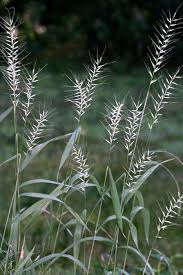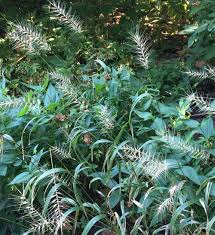Bottlebrush Grass, scientifically known as Elymus hystrix, is a unique and interesting plant that can be found in various parts of North America. This type of grass is easily recognizable due to its distinct appearance, resembling the shape of a bottle brush, which gives it its common name.
One of the remarkable features of Bottlebrush Grass is its long, bristle-like flower spikes that emerge from the plant during the flowering season. These spikes closely resemble the bristles of a traditional bottle brush, hence the name. These flowers are usually tinged with a purplish hue, adding a touch of color to the landscape.
This grass species is well-suited to a variety of environments, from woodlands to prairies. Its adaptability makes it a valuable component of many ecosystems, providing food and habitat for various animals and insects. The deep root system of Bottlebrush Grass plays an essential role in preventing soil erosion, making it a valuable plant for maintaining the stability of the land.
Gardening enthusiasts often appreciate Bottlebrush Grass for its ornamental value. It can be cultivated in gardens to add a natural and wild element to the landscape. Additionally, the unique appearance of its flower spikes can make for an intriguing focal point.
In terms of care, Bottlebrush Grass is relatively low-maintenance. It typically thrives in well-draining soils and can tolerate a range of soil types. This grass is generally drought-tolerant once established, reducing the need for frequent watering. As with any plant, providing it with the appropriate growing conditions will help it flourish.
In addition, Bottlebrush Grass (Elymus hystrix) is a captivating plant with its distinctive bottle brush-like flower spikes and adaptability to various environments. Its ecological significance, ornamental value, and low-maintenance nature make it a fascinating and valuable addition to both natural landscapes and gardens alike. Whether you’re a nature enthusiast or a gardener, this grass is sure to catch your attention and provide a touch of uniqueness to your surroundings.
Read Also: Fattening of Sheep and Goats Complete Guide
Growing Care Guide of Bottlebrush Grass

Here’s a simple growing guide for Bottlebrush Grass (Elymus hystrix):
1. Choose the Right Location: Select a sunny to partially shaded spot in your garden or landscape. Bottlebrush Grass can tolerate a range of soil types but prefers well-draining soil.
2. Planting: Plant seeds or young plants in the spring or fall. Prepare the soil by loosening it and removing any weeds. Plant the seeds at a depth of about 1/4 inch and space them according to the recommendations on the seed packet or plant tag.
3. Watering: Water the newly planted grass regularly to keep the soil consistently moist until it becomes established. Once established, Bottlebrush Grass is relatively drought-tolerant and will only need occasional watering during prolonged dry periods.
4. Mulching: Applying a layer of mulch around the base of the plants can help retain moisture, suppress weeds, and regulate soil temperature. Use organic mulch like wood chips or straw.
5. Fertilizing: Bottlebrush Grass generally doesn’t require heavy fertilization. A light application of a balanced, slow-release fertilizer in the spring can help promote healthy growth. Follow the instructions on the fertilizer package.
6. Pruning: Pruning is not usually necessary for Bottlebrush Grass. However, you can trim back any dead or damaged foliage in the late winter or early spring before new growth emerges.
7. Pest and Disease Management: Bottlebrush Grass is relatively resistant to pests and diseases. However, keeping the area around the plants free of debris and maintaining good air circulation can help prevent potential issues.
8. Propagation: If you want to propagate Bottlebrush Grass, you can divide mature clumps in the spring or fall. Dig up the clump and carefully separate the sections, then replant them in suitable locations.
9. Winter Care: Bottlebrush Grass is hardy and can withstand cold temperatures. No special winter care is typically required. The grass may die back in the winter but will regrow in the spring.
Remember that every gardening situation can be unique, so observe your plants closely and adjust your care routine accordingly. With its natural charm and easygoing nature, Bottlebrush Grass can be a wonderful addition to your outdoor space, contributing to the beauty and health of your garden.
Benefits and Uses of Bottlebrush Grass
Here’s are the benefits and uses of Bottlebrush Grass (Elymus hystrix):
Benefits
1. Erosion Control: The deep root system of Bottlebrush Grass helps prevent soil erosion, making it valuable for stabilizing slopes and preventing loss of topsoil during heavy rains.
2. Wildlife Habitat: The grass provides habitat and food for various wildlife, including birds, insects, and small mammals. It contributes to biodiversity and supports local ecosystems.
3. Low Maintenance: Bottlebrush Grass is relatively low-maintenance once established. It requires less water than many other grasses and doesn’t need frequent fertilization.
4. Ornamental Value: With its unique bottle brush-like flower spikes, Bottlebrush Grass can add an intriguing and naturalistic element to gardens, landscapes, and even flower arrangements.
5. Drought Tolerance: Once established, Bottlebrush Grass exhibits good drought tolerance, making it a suitable choice for regions with periodic water shortages.
Uses
1. Landscaping: Bottlebrush Grass can be used in landscaping to create naturalistic and wild-looking gardens. It works well in cottage-style gardens, native plant gardens, and informal landscapes.
2. Erosion Control: Due to its deep root system, Bottlebrush Grass is often planted on slopes, embankments, or areas prone to erosion to stabilize the soil and prevent erosion.
3. Wildlife Gardens: Planting Bottlebrush Grass can attract birds, butterflies, and other pollinators to your garden, enhancing its ecological value.
4. Restoration Projects: The grass is used in ecological restoration projects to re-establish native plant communities in disturbed or degraded areas.
5. Naturalization: Bottlebrush Grass can be utilized to enhance the natural beauty of open spaces, meadows, and prairies.
6. Educational Purposes: Schools and nature centers may incorporate Bottlebrush Grass into their outdoor spaces to educate students and visitors about native plants and their ecological importance.
7. Soil Stabilization: It’s commonly used on construction sites and other areas where soil disturbance has occurred to stabilize the soil and prevent runoff.
8. Habitat Creation: By providing food and shelter, Bottlebrush Grass contributes to creating habitats for wildlife in urban and suburban areas.
9. Dried Arrangements: The unique flower spikes can be dried and used in floral arrangements, adding an interesting texture and shape to bouquets.
Remember that local regulations and environmental considerations should be taken into account when using native plants like Bottlebrush Grass in various applications. Its multiple benefits and diverse uses make it a valuable asset for both functional and aesthetic purposes in various settings.
Read Also: How to Increase Sheep Milk for Maximum Profit
Where to Find Bottlebrush Grass near Me/You

Bottlebrush Grass (Elymus hystrix) can be found in various regions of North America. Here are some common places where you might locate or find Bottlebrush Grass:
1. Native Habitats: Look for Bottlebrush Grass in its natural habitats. It is often found in woodlands, prairies, meadows, and along the edges of forests. You can find it growing in both sunny and partially shaded areas.
2. Natural Areas and Parks: Many natural areas, parks, and nature reserves may have Bottlebrush Grass growing in their native plant communities. Take a stroll through these areas to spot the grass in its natural setting.
3. Botanical Gardens: Some botanical gardens may have sections dedicated to native plants, including Bottlebrush Grass. These gardens often showcase a variety of plant species from different regions.
4. Native Plant Nurseries: Local nurseries that specialize in native plants are excellent places to find Bottlebrush Grass for purchase. They might have potted plants or seeds available for you to start your own garden.
5. Wildlife Refuges: Wildlife refuges and conservation areas may host Bottlebrush Grass as part of their efforts to restore native plant populations and provide habitat for wildlife.
6. Online Plant Retailers: There are online retailers that specialize in native plants. You can search for Bottlebrush Grass and have plants or seeds shipped to your location.
7. Garden Shows and Sales: Native plant societies, gardening clubs, and environmental organizations often host plant sales and events where you might find Bottlebrush Grass for sale.
8. Local Landscapes: Bottlebrush Grass might already be growing naturally in your local landscapes, especially in more rural or natural areas. Observe road edges, fields, and undisturbed land for its presence.
When looking for Bottlebrush Grass, it’s a good idea to do some research to ensure that you’re sourcing plants from reputable sources and adhering to any local regulations regarding native plant collection and cultivation. Whether you’re interested in incorporating it into your garden or observing it in its natural habitat, Bottlebrush Grass offers a unique and valuable presence.
Read Also: How to Make Money from Electronics Recycling (E-waste Recycling)
